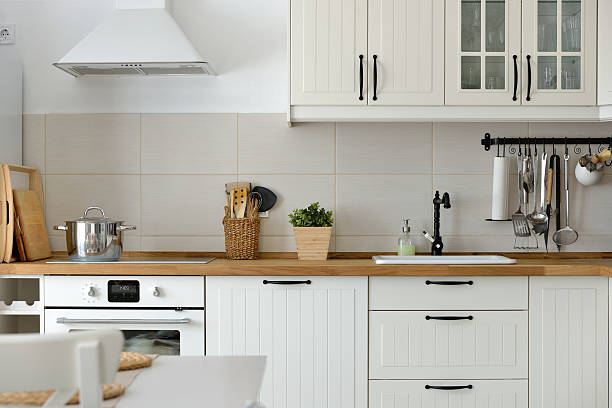契約者向け, キッチンはキャビネットやカウンタートップを設置するだけではありません; それは高機能なものを作ることです, お客様と出会う永続的な空間’ 日々の要求. 堅牢なキッチン収納ラックや多用途のキッチン収納棚から統合されたキッチンキャビネット収納システムまで、適切なキッチン収納ソリューションを選択することが成功の基本です。. 不適切な選択は住宅所有者の不満を招く, コールバック, そして風評被害. これら 5 つの重要な要素をマスターして、プロジェクトを向上させ、クライアントを満足させる情報に基づいた意思決定を行ってください。.
スペースアセスメント & 測定精度
キッチン収納製品を検討する前に, 細心の注意を払ってスペースを評価することが最も重要です. これは基本的なキャビネットの設置面積をはるかに超えています.
- 総合的な寸法: すべてを文書化 – 部屋全体のサイズ, 天井の高さ, 窓/ドアの配置, アプライアンスの正確な位置 (ドア/引き出しの隙間を含む), 配管と電気の荒らし, そして通気. 軒天井も忘れずに, 隔壁, および構造上の突起物. わずかな計算ミスでも、カスタムのキッチンキャビネット収納ユニットが使用できなくなる可能性があります.
- ワークフロー & ゾーン: キッチンのワークフローを分析する. プライマリゾーンを特定する (準備, 料理, クリーニング, ストレージ) そしてそれらの間の道. ストレージがサポートする必要がある, 邪魔しない, この流れ. 鍋用のキッチン収納ラックをコンロの近くに配置する, 食器洗い機/シンク近くの食器用のキッチン収納棚, パントリーの論理的な収納.
- アクセシビリティ & クリアランス: ドアの揺れを考慮する (家電製品とキャビネット), 引き出しの拡張, そして安全な散歩道. アプライアンスが開いており、キャビネットのドア/引き出しが完全に拡張されている場合は、十分なスペースを確保してください。. これにより、キッチンのオーバーヘッド収納棚とベースキャビネットの奥行きと配置が決まります。.
- 将来性のある: 将来のアプライアンスのアップグレードの可能性を検討する (大型冷蔵庫やレンジなど) 異なる空間的余裕が必要になる可能性があります.

重要事項
キッチン収納コンポーネントに使用される素材は寿命に直接影響します, 外観, 掃除のしやすさ, そしてコスト. クライアントのライフスタイルと予算に合わせた選択を導きます.
キャビネットボックス
- 合板: 業界のゴールドスタンダード. 優れた強度, ネジ保持能力, 耐湿性 (特にバルティックバーチ), 歪みも最小限に抑えられています. キッチンキャビネットの収納に重い荷物を入れて長持ちさせるために不可欠です.
- パーティクルボード/MDF: 費用対効果の高いオプション. パーティクルボードは多量の湿気にさらされると膨張する傾向があります。. MDF は塗装仕上げに適していますが、水による損傷を受けやすいです。. 耐久性を高めるために高品質のメラミンまたはラミネート コーティングが必要. 湿気のリスクが低い場所での使用に最適.
キャビネットのドア & 引き出し前部:
- 無垢材: 古典的な美しさ, 耐久性のある, 修理可能. 膨張/収縮を最小限に抑えるには安定した湿度が必要です. コストが高い.
- 加工木材 (ベニヤ付きMDFコア): 安定した, 塗装または染色仕上げに最適, 費用対効果. ボール紙コアを避ける.
- サーモフォイル: MDFに融着された耐久性のあるプラスチックラミネート. 耐湿性が高い, 掃除が簡単, 予算に優しい. 木製に比べてスタイルや色の選択肢が限られている.
- アクリル/高光沢ラミネート: モダンな美学, 非常に耐久性があり、拭き取りやすい. 汚れや湿気に強い.
棚 & ラックの材質
- ステンレス鋼: キッチンの収納ラックに最適 (ポットラック, 引き出しトレイ) 商業スタイルのオープンキッチン収納棚. 耐久性が高い, 耐性耐性, 衛生的な, 熱や重量をうまく処理します. 指紋や傷が付く可能性がある.
- 頑丈なワイヤー: パントリーやベースキャビネットの引き出しに優れた通気性を発揮. 強い, 掃除が簡単. ゲージが十分な厚さであることを確認してください.
- 無垢材/強化積層板: キャビネット内の固定キッチン収納棚の標準. 適切な厚さを確保する (3/4″ 分) 耐荷重のための適切なサポート/ブラケット.
- 強化ガラス: おしゃれな棚に使用, 視覚的な明るさを追加します. 慎重な取り扱いと確実な取り付けが必要です.

ストレージ システムの種類 & 統合
現代のキッチン収納は静止した棚をはるかに超えています. 適切なシステムは、使いにくいスペースを高機能資産に変えます。.
ベースキャビネット革命:
- 深い引き出し: 標準の棚よりもはるかに優れており、後ろのアイテムにアクセスできます. 鍋にぴったり, フライパン, 食器, そしてパントリーのオーバーフロー. 堅牢性を指定する, 重量級のフルエクステンショングライド.
- 引き出し棚 & トレイ: コーナーベースキャビネットに必須 (魔法の角), パントリー, そしてシンクの下. コンテンツを視界に入れて手に届くようにする. ワイヤーまたは無垢材のオプションが利用可能.
- 特殊インサート: 引き出し式ゴミ箱/リサイクル箱, トレイの仕切り, スパイス引き出し, 縦型トレイ収納, まな板用ペグシステム. キッチンキャビネットの収納にシームレスに統合.
ウォールキャビネット & 棚ソリューション:
- 調節可能な棚: 標準, ただし、高品質のシェルフピンと適切な厚さを確保してください.
- プルダウン棚: 高いキャビネットの内容物を手の届くところに安全に持ち込む.
- オープンシェルフ (キッチン収納棚): 美しさとアクセスの良さで人気. 規律ある組織が必要. 頑丈なブラケット/取り付け金具を使用する. 素材を検討する (木材, 鋼鉄, ガラス) 深さも慎重に. 調理中の飛び散りゾーンの近くには理想的ではありません.
- 前面ガラスキャビネット: ホコリを防ぎながら陳列する.
垂直方向のスペース & 特殊ラック:
- トールキャビネット/引き出し式パントリー: 食品の垂直方向の保管を最大限に活用する, 家電製品, 掃除用品. 統合されたオーガナイザーが鍵となる.
- ポットラック (キッチン収納ラック): 天井取り付けまたは壁取り付け. 貴重なキャビネットスペースを解放します. 天井梁または壁の間柱に確実に取り付けてください。. 高さのクリアランスを考慮する.
- ドア取り付け式収納庫: スパイス用ラック, 蓋, まな板, ホイル/ラップ. キャビネットのドアを閉めたときの隙間に注意してください.
- 家電ガレージ: カウンタートップの家電を収納. リフトアップまたはタンブールドアとアクセシブルなコンセントを備えています.

クライアントのライフスタイル & 機能的ニーズ
最も効率的なキッチン収納システムも、クライアントの実際の生活やスペースの使い方と一致していなければ機能しません。.
- 料理人: 鍋やフライパンを置くコンロの近くに高性能のキッチン収納ラックが必要, 簡単にアクセスできるナイフの保管場所, スパイス専門組織, 十分な準備スペース, 便利なゴミ箱/リサイクル用引き出し. 多くの場合、深い引き出しが好まれます.
- エンターテイナー: ガラス製品を保管するための十分な保管場所が必要, 大皿, 病気になる, そしてテーブルリネン. 展示品用に専用のキッチン収納棚やキャビネットを検討する. 飲料センターやコーヒーメーカー/ブレンダー用の家電ガレージが便利です.
- 家族/忙しい家庭: 耐久性を要求する, 掃除が簡単な素材. スナック類を収納できる豊富な収納スペース, お弁当作り用品, 子供向けの料理, そしてまとめ買い (深いパントリー). アクセスしやすい組織は重要です. メール/キーのコマンドセンターについて考える.
- アクセシビリティのニーズ: 現場熟成またはユニバーサルデザイン向け, アクセスしやすい収納を優先する (ドアの上の引き出し), プルダウン棚, D型の取っ手, 高いキャビネットを避ける. 特定のアクセシビリティ ガイドラインを参照してください.
- 美的嗜好: クライアントは洗練されたものを望んでいますか, ハンドルレスキャビネット (プッシュして開く)? 暖かい, オープン木製棚? 閉じたキッチンキャビネットの収納とディスプレイエリアの組み合わせ? ストレージの選択肢は視覚的に統合する必要がある.

予算の現実 & バリューエンジニアリング
野心的なストレージ ソリューションと財務上の制約のバランスをとることは、請負業者の中核となるスキルです. 明確な選択肢と価値を提供する.
- 透明性のある段階的な価格設定: オファーパッケージ: “良い” (標準棚, 基本組織), “より良い” (主要エリアの引き出しをアップグレード, いくつかの引き出し), “最高” (完全なカスタマイズ, プレミアムインサート, 特化したキッチン収納ラック).
- 影響の大きいゾーンを優先する: 最も重要なストレージ ソリューションに予算を割り当てます。. コンロやシンクの近くの深い引き出しに贅沢を. 整理整頓されたパントリーを優先する. アクセス頻度の低い上部キャビネットには標準の棚を使用します.
- 材料の混合: キャビネットボックスと摩耗しやすい部分には高級合板を使用, ただし、コスト効率の高いドア素材またはサーモフォイルを検討してください。. オープンキッチンの収納棚を戦略的に使用して、高価な上部キャビネットのドアの必要性を減らします。.
- 標準サイズとの比較. カスタム: 可能な限り標準的なキャビネット サイズを活用する; カスタムキッチンキャビネットの収納コストが大幅に増加. 標準ボックス内で賢い挿入と引き出しを使用して機能を追加します.
- 段階的アプローチ: 今すぐコアキャビネットを設置し、特殊なインサートを追加することを提案します (ポット用の引き出し式キッチン収納ラックなど) 後は予算が許す限り. キャビネットが将来のアップグレードに備えて準備されていることを確認する.

結論
契約者向け, キッチンの収納場所を指定することは二次的な作業ではありません; 機能的なサービスを提供する上で中心的な役割を果たします, 満足のいく, そして長く使えるキッチン. 空間を厳しく評価することで, 耐久性のある適切な材料の選択, お客様の生活に合わせた先進のストレージシステムを統合, 予算を賢く管理する, 単にキャビネットを設置するだけでなく、卓越した料理作業スペースを作るまで仕事をレベルアップさせます。. キッチン収納ラックを使いこなす, キッチン収納棚, 洗練されたキッチンキャビネットの収納ソリューションにより、真の価値を提供する知識豊富な専門家としての地位を確立できます。, コールバックを最小限に抑え、クライアントの紹介を最大化する. 適切な収納に時間を投資しましょう – それは本当に機能するキッチンの基礎です.















